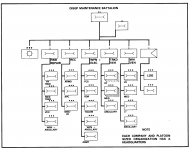But,
Politically, what is the effect if the 1 CMBG is tasked to a major effort and then takes casualties at the rate of the First Day of the Somme, or even Verrieres Ridge?
I can easily see the infantry battalions switched around even if the rest of the brigade structure is shipped over, and employed, intact.
The CF recruiting method for the reg force isn't like that -- while that applies to the reserver units - it doesn't apply to the regular Army.
Losing a village won't happen if 1 VP was wiped out one day.
Besides the PPLCI has a long Regimental tradition of being wiped out and reconstituted...
The cardinal rule is if 3 CF Officers get together - they form a HQ.
Just looking at the current ORBAT I am legimiately confused by the number of seemingly redundant HQ's.
Any actual change needs to start at the ground up - then justify everything above it.
Ideally this would start with filling line units to full strength.
Then their Higher Command HQ and Support functions.
I suspect that the Army would quickly run out of bodies
For instance looking at the Rifle Bn
4 x 180 man Rifle Coy = 720
1 x Recce Platton. = 40
1 x Sniper Troop. = 16
1 x Adm/Spt Coy. =140
1 x HQ = 84 (just to make it even)
That is without a fully Cbt Spt Coy
So 9 of those =9000 bodies
Arty Reg't
3 x 8 Gun Bty = 420
8 Gun Bty = ~ 140 (been a while since I look at this but 10 / gun, 2 CP's @ 5 each, Recce @ 6, 2 OP's @4, BC's Party/DCC @ 8, plus TSM's, BCM, BK etc - so 140 sound sounds good/ BTY
1 Adm Bty
I've not been paying attention for a while, but radar guys, AD Bty, Mortars (cause apparently Infantry can't be trusted)
Your at 600 min there
2 RCHA, a RALC, and W Bty in Gagetown = there is at least 2000 bodies.
I'm even worse at the Engineer Regiment math
3 sections @10 / troop (plus Troop Cdr, TSM, etc. - lets say 45
2 troops / Squadron so at least 120 / Sqn
3 Sqn / Reg
so 360 in just Field squadrons
Then Heavy Equipment Sqn at another 120
CSS Squadron
etc
Lets call it 600 there too
so 3 CER's (I can't recall the French term) plus the Airfield folks - I'll be low here - but 2,000
Now the Armored - I never paid attention to them - so bear with me here)1
4 tanks / platoon (4 folks in a tank) 16
2 Platoon/ Troop - 50 inc HQ / troop
2 Troops / Sqn so 120 ish / Sqn
3 Sqn Reg 360
Recovery Sqn ~ 120
Recce Sqn ~ 120
HQ folks - say 700 total?
3 Armored units - so 2,100
So we are over 15k in just Cbt Arm PY's
No Service BN
No Comms Reg
No Higher HQ's
Having 1 Can Div HQ is a stretch - having more is like putting your boots on without getting dressed and heading out to work.




